The highest special rank in the internal affairs bodies. Placing stars and plates on the shoulder straps of the FPS personnel
Shoulder straps are an essential attribute of any military or law enforcement officer in most countries of the world. How long ago did they appear in Russia? How to distinguish them depending on the specific military rank? Are military-style shoulder straps different from those worn by employees law enforcement? Are there government standards regulating appearance insignia in the army and law enforcement agencies? In this article, we will try to answer all these questions, along the way we will analyze how the mentioned attributes of the uniform of the junior and senior command personnel look like, including the shoulder straps of the major. Photos will also be presented.
History of army insignia
A number of historians agree that before an army appeared in Russia, functioning on a regular basis, the external difference in military ranks had very few criteria. The senior and junior ranks differed only in the cut of clothing and the type of weapon. Some modernization took place during the time of Peter the Great. Officers began to wear gorgets (badges in the form of a scarf, on which elements of state heraldry were present). V early XIX centuries in the Russian army were introduced uniforms, design close to modern ("tailcoat"). Headdresses appeared, emphasizing the difference in military ranks. Epaulettes gradually came into fashion. They matched the color of the officers' uniforms, while the generals had golden hues. Some examples of epaulettes made it possible to distinguish between, say, chief and staff officers. True, this insignia did not say anything about military ranks. 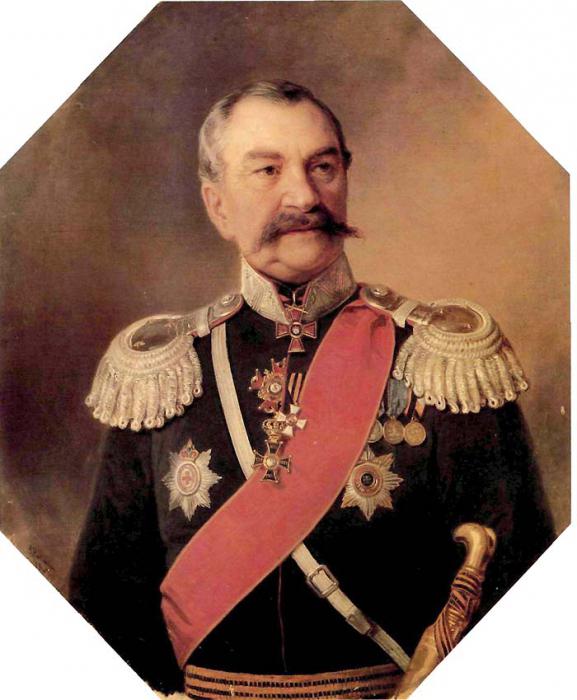
In the 20s of the XIX century on military uniform Russian soldiers appeared asterisks. One meant that the military had the rank of ensign, two - major, three - lieutenant colonel, four - staff captain. The colonels, however, wore epaulettes that had no stars at all. In the 1840s, non-commissioned officers acquired insignia in the form of transverse stripes, somewhat similar to the stripes in the Soviet Army from sergeants.
Shoulder straps and stars in more or less modern form appeared in Russia in the middle of the 19th century. Some historians associate their appearance with the introduction of a new model of clothing - a marching overcoat. Shoulder straps, on which galloons and stars were sewn (it is noteworthy that all officers, including the highest ranks, had the same size), were fixed on the shoulders of the uniform.
After the 1917 revolution, stars and shoulder straps, as one of the symbols of the tsarist regime, were abolished. But over time, the military leadership of the USSR began to return to historical insignia. First, there were stripes on the sleeves, and in 1943 - shoulder straps. Photo and video materials of those years make it possible to study their features in detail.
Shoulder straps in the USSR army
In January 1943, the Decree of the Supreme Soviet of the USSR was adopted on the introduction of shoulder straps for the Red Army. From that moment on, this insignia was certainly present on the clothes of Soviet soldiers, and then Russian ones. Many historians agree that the appearance of shoulder straps in the USSR could be considered a sensation: in a relatively recent - relative to that moment - historical retrospective, this element military clothing He was openly despised by the Bolsheviks, as he was strongly associated with tsarism. In the Red Army, two types of shoulder straps appeared (just like in the imperial, by the way): for wearing in the field and everyday. The first differed in camouflage color ("khaki"), trimmed with colored piping. 
On the shoulder straps, intended for everyday wear, there was an emblem, the corresponding one, as well as brass buttons. The insignia of the rank and file sometimes contained the number of the military unit. One of the fundamental differences, according to a number of military historians, between the tsarist and Soviet shoulder straps is in the size of the stars. In the USSR, they were larger.
Some historians note the following fact: since the introduction of shoulder straps in the USSR, the military began to gradually return forgotten word"Officer", actively used during the tsarist regime. Under Soviet rule, this category of the military was called command and control personnel. Sometimes the expression "commander of the Red Army" was used.
The term "officer" was not legally established in the Soviet Union. At first, it was used informally, in oral conversations. But over time, he entered the army document flow on a completely official basis. True, as historians note, in some orders of 1942, the word "officer" was still present.
Stars on epaulettes
In the army Russian Empire, in the Soviet troops (after 1943) and the modern armed forces of the Russian Federation, stars act as one of the main elements on shoulder straps. V different periods time, their shape and color may differ. There were pure gold stars on shoulder straps, silver, metal. At the time of approval in 1943, they were flat, and only over the years did they acquire a three-dimensional shape - they became ribbed, with corrugated elements. The diameter of large elements is 20 mm, of small ones - 13 mm. At first Soviet army supplied with brass stars, later - aluminum. Until the early 80s, they had a silver color, then - golden (with the exception of the stars for field epaulets - they were dark green and made of steel).

These features of army stars, formed in Soviet years remain relevant for modern Russian troops... Changes, if any, are small. Sometimes in the army of the Russian Federation there are stars of a khaki color or ordinary green. Also, parts made of metal now have smoothed edges in most cases. Other notable innovations include "false runners", on which various elements, including stars, are painted with paint. Their use is almost always limited field uniform... According to some military experts, the soldiers liked the "false patches" because of their convenience - ordinary metal stars could cling to backpacks, vests, shine in the sun and thus give the soldier to the enemy.
The main formats of military shoulder straps in the Russian Federation
The appearance of the shoulder straps of modern Russian officers was first approved by the Decree of the President of the country in 1994 and a similar legal act in 2010 (and its subsequent editions). The symbols typical of the Soviet era (the hammer and sickle were replaced by the Russian one. According to the standards adopted at the highest state level, shoulder straps should have a rectangular shape (the upper edge is in the form of a trapezoid), have a color - golden or matching the tones of the uniform. different departments have a piping of a certain color, and there is a button on these attributes of the form.
In the Airborne Forces, the Air Force of the Russian Federation, space forces shoulder straps are equipped with a blue piping. In the FSB, the Service of Special Objects and Federal Service there is no protection of this element on shoulder straps at all, or it
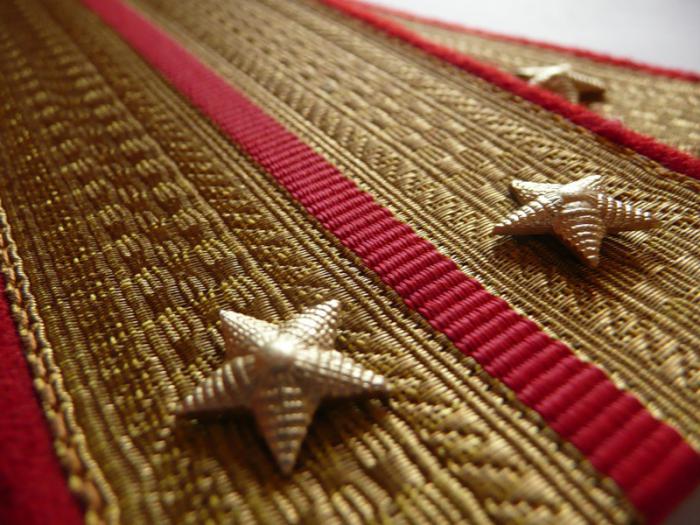
Distinctive feature have shoulder straps of the Marshal of the Russian Federation - a star is located on their longitudinal axis, and the edging is red.
Stars on the insignia of soldiers modern army RF are also located in accordance with the standards. The shoulder straps of the general of the army are distinguished by one star, the size of which is larger than that of lower-ranking officers, whose rank contains the word "general". The color of the edging depends on the type of troops. The epaulettes of admirals of the fleet have a similar format. They bear one star, larger in size than those on the insignia of the vice and rear admirals.
Shoulder straps approved in the Russian Federation have such an element as gaps. Their number depends on the rank of the soldier. The shoulder straps of the colonel of the Russian army and the major contain two gaps. Captain, lieutenant - one.
Russian army rank and file
Inferior military rank, approved in the army of the Russian Federation, - private. It was officially established in 1946, before that the soldiers were called fighters or Red Army men. Sometimes other words are added when referring to a soldier. For example, an ordinary justice (if it comes about the military reserve). In the navy, the analogue of the rank of private is a sailor. Soldiers who have achieved some success in carrying military service, can get the rank of corporal (in the navy - senior sailor). In the absence of superior commanders, they can control a platoon of privates (sailors). How to determine both military ranks by shoulder straps? It's very simple: the private on the insignia has the abbreviation ВС and there is no additional elements... The corporal has a stripe. 
The next rank for the rank and file is junior sergeant. As a rule, corporals receive it for any merits or good discipline, sometimes when they are discharged from the army to the reserve. In the navy, the rank of junior sergeant corresponds to the rank of petty officer of the second article. A soldier can be promoted to sergeant. The same title can be obtained by a cadet of a military school. Ranked higher in ground forces ah - foreman. An interesting fact is that this title and exactly the same in sounding in the Navy are not the same. The sergeant major is considered two steps higher than the sergeant. On ships it is different. There, a sergeant-major is a soldier corresponding to the rank of a land sergeant. Higher up in the ground forces is the senior sergeant. In the Navy, he is also the chief ship sergeant. Further, a soldier of the Russian army can rise to the rank of warrant officer (in the navy - midshipman), and then - to acquire the rank of "senior".
On the shoulder straps of the junior sergeant there is an abbreviation for the Armed Forces and two stripes. The sergeant has three, the senior has one wide stripe. The foreman wears shoulder straps with one wide and one narrow stripe. Warrant officers and warrant officers wear two stars on their shoulder straps, and three stars in the senior rank. The arrangement of the stars on the shoulder straps is in one row.
Junior officers
The junior officer corps is understood as a set of army ranks, ranging from junior lieutenant (who is considered higher in rank than ensign) to captain (lower in rank than major). Often, servicemen present in battalion units, platoons and companies are also referred to as junior officers. Graduates of higher educational institutions of a military profile (or students of the last courses of these institutions) can receive the rank of junior lieutenant. In some cases (for example, if there are not enough officers to perform a certain group of tasks), this rank can be assigned to a graduate of a regular civilian university. However, the rank of lieutenant can only be obtained by the soldier who has served in the army. Similarly, military personnel are assigned the rank of senior lieutenant. Junior officers include soldiers with the rank of captains. 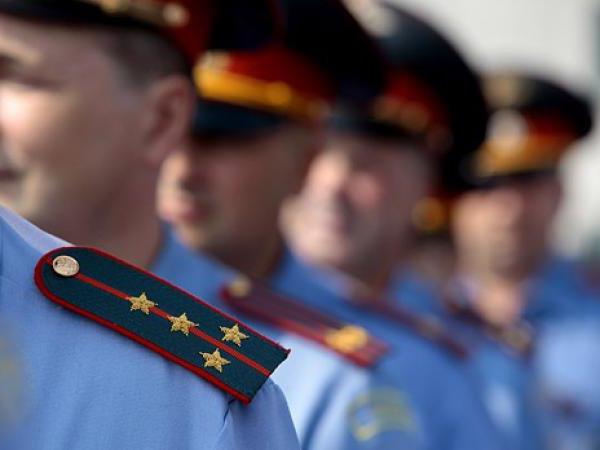
An interesting fact is that it is the location of the stars on the shoulder straps, and not their number, that distinguishes junior officers from representatives of the rank and file of the army. Here are some examples. A lieutenant's shoulder straps contain only two stars, while a soldier of lower rank - a senior warrant officer - has three. However, the officer's stars are located in the neighborhood and across the shoulder strap. While the warrant officer - in a line along. The senior lieutenant has three stars, they are arranged in the form of a triangle, the distance of the stars on the shoulder straps is the same. The captain, in turn, has four stars. Three of them are in the form of a triangle, and another one of the same size for the captain's shoulder straps is placed in the area that is closer to the collar of the uniform. The junior lieutenant wears shoulder straps with one star in the middle of the shoulder strap (slightly closer to the edge relative to the middle).
Senior officers
A soldier who has received the rank of major can rank himself as a senior officer. An interesting fact is that the words spoken additionally when referring to a soldier of this rank in the reserve may coincide with those that are used when referring to a private. The captain of the ground forces in the Russian fleet corresponds to a rank with a similar sound, but the phrase "third rank" is added. Above the major is a lieutenant colonel (in the navy, a captain of the second rank), then a colonel (in the navy, a captain of the first rank).
If, when comparing the insignia for junior officers and rank and file of the army, the location of the stars on the shoulder straps played a decisive role, then for the senior category of officers the size of these elements is of decisive importance. Here are some examples. The junior lieutenant has one star on his shoulder straps. A major superior to him by several steps in rank also has one star. But they differ in size. Major's shoulder straps are decorated with a larger star. The insignia of a lieutenant and a lieutenant colonel are similarly correlated. Both have two stars. But the senior officer has a lot more.
Exactly on the same basis, one can distinguish between the shoulder straps of a colonel of the Russian army and a similar insignia for a senior lieutenant. Both have three stars. The junior officer wears those that are much smaller. The distance of the stars on the shoulder straps is the same. By the way, the captain's shoulder straps are unique in their kind. Only they have four stars. None of the officers have more or the same number. As for the comparison of shoulder straps of servicemen of different ranks in the navy, exactly the same rules apply there.

Senior officers
At the top of the hierarchy of ranks in the Russian army is the highest officer corps. The first step is occupied by a major general (in the navy, he is assigned to a rear admiral). These are officers in command of divisions, the number of which exceeds 150 thousand soldiers. Next comes the lieutenant general (and this despite the fact that in the lower officers, the major is more important than the lieutenant). Historically, the lieutenant general took over the functions of more high level(for example, some of those under the jurisdiction of an army general). In some cases, a representative of the senior officers of the Russian Armed Forces may be appointed to a position in the General Staff or the Ministry of Defense of the Russian Federation. As a rule, the servicemen of this category carry the rank of colonel-general. In the navy, they correspond to their ranks. An officer at the highest rank in the armed forces of the Russian Federation is a general of the army, in the navy it is an admiral of the fleet.
To correctly distinguish the ranks of senior officers from junior and senior, you need to take into account many nuances: the location of the stars on the shoulder straps, their size and even color. There are options when it is difficult to make a mistake, for example, if a colonel is wearing shoulder straps. How many stars he has on his shoulder straps, we have already noted above - three. The senior lieutenant has the same number, but their size is smaller. For both military men, they are located in a triangle - no one else has such an arrangement. There is a high probability of making a mistake when recognizing the shoulder straps of a major general. They have one star. Major's shoulder straps also contain a single asterisk. The same situation is with the attributes of the junior lieutenant's uniform. Unmistakably recognize top officer it is possible due to the absence of other elements (stripes) on its shoulder straps. Another example is a lieutenant general. Military shoulder straps in this rank contain two stars located along. In the same way as the ensign. But the top officer has more stars. A similar example is the colonel general. His shoulder straps contain three stars - the same as that of the senior warrant officer. The difference is still the same size.

Shoulder straps in the police of the Russian Federation
Ranking by rank and the use of shoulder straps as insignia is used not only in the Russian army, but also in law enforcement agencies, including the police. Due to some similarity between the types of activities - military and law enforcement, the principles of the arrangement of stars and other elements on shoulder straps in the police are generally similar to those that are characteristic of the Russian army.
The rank and file of the police does not have any elements on the shoulder straps. An exception is the insignia of the cadets, who have the letter "K" on them. Above the rank and file in the police ranks is the junior commanding staff, represented by sergeants, foremen and warrant officers. The key element in the insignia characteristic of these titles are stripes and asterisks. The sergeants, regardless of their level, have no stars. The younger ones have two thin stripes, the sergeants have three, the older ones have one wide.
![]()
The Chief of Police owns shoulder straps with one wide longitudinal stripe. The insignia of a warrant officer is characterized by the presence of asterisks: the usual has two, the older has three. They are located in a row. The middle commanding staff is represented by ranks from junior police lieutenant to captain. Their shoulder straps are characterized by the presence of a "gap" - a red stripe running in the middle. There are asterisks: a junior lieutenant has one, an ordinary lieutenant has two, a senior lieutenant has three. The police captain's shoulder straps contain four stars. Next in rank is the senior commanding staff. The shoulder straps of this category of police officers contain two "gaps". Ranks differ in the number of stars. On the shoulder straps of the major - one. The lieutenant colonel has two. Colonel's shoulder straps contain three stars. The highest commanding officers of the police are generals. They wear shoulder straps without "gaps", with stars larger than those of middle-ranking officers. The Major General has one star. Higher-ranking police officers have more: the lieutenant general wears shoulder straps with two stars, the colonel general - with three.
Highest military rank in the Russian Federation
The highest military rank in our country is Marshal Russian Federation... It was legislatively established in 1993 and replaced the title of Marshal. Soviet Union... V recent history It was assigned to Russia only once. It was awarded to the Minister of Defense of Russia Igor Sergeev in 1997. The Marshal of the Russian Federation wears shoulder straps with one large star, as well as one of the symbols of Russia and the main elements of the state emblem of the country. 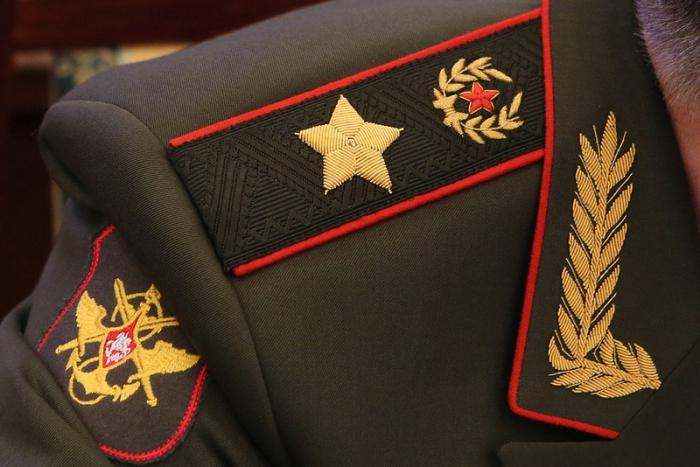
Igor Sergeev was born in the Ukrainian SSR in 1938. He served in the Armed Forces of the USSR since 1955. In 1960, he transferred to the service where he rose from the head of the department to the post of Commander-in-Chief. In 1973 he graduated with honors from the Military Academy. Dzerzhinsky, in 1980 - the Military Academy of the General Staff of the USSR. After the collapse of the Soviet Union, he continued to serve in the army of the Russian Federation. Between 1992 and 1997 he commanded Rocket Forces country. Improved the level of combat training of troops, provided technical equipment. He supervised the introduction of new missile systems into the army. In May 1997, he was appointed Minister of Defense of the Russian Federation. He was a member of the Security Council and the Presidium of the Russian Government. In November, Igor Sergeev was awarded the title of Marshal of the Russian Federation. Until now, none of the Russian military personnel has been awarded it. In 2001, Igor Sergeev resigned and became an assistant to the President on issues related to strategic stability. He worked in the field of negotiation processes on missile defense systems, strategic weapons, nuclear nonproliferation issues. He held the position until March 2004. After long illness passed away on November 10, 2006. A memorial plaque dedicated to Igor Sergeyev was installed in the Donetsk region (Ukraine).
Since the employees of the FPS EMERCOM of Russia are militarized, they have the appropriate uniforms and insignia. The insignia, depending on the special ranks, located on the shoulder straps, for the FPS employees were established by order of the Ministry of Emergency Situations of the Russian Federation dated July 3, 2008 N 364 "On approval of the Rules for wearing uniforms by employees of the State Fire Service of the Ministry of the Russian Federation for civil defense, emergencies and elimination of the consequences of natural disasters with special titles internal service", and are identical to the corresponding signs for police officers.
The basis for placing insignia made in the form of plates and stars is the shoulder strap.
Persons of middle and senior commanding staff wear epaulettes:
- on tunics (jackets) with a dress uniform - sewn-on shoulder straps with a field of golden color, with gaps and orange piping;
- on tunics (jackets) with everyday form clothes, demi-season jackets, coats and winter jackets - sewn on shoulder straps with a field of gray of blue color, with gaps and orange edging;
- on woolen and summer jackets - removable shoulder straps with a gray-blue field, with gaps and orange edging;
- on shirts (blouses) of white and gray-blue colors - removable shoulder straps with a field, respectively, white and gray-blue, with gaps and orange edging;
Individuals of private and junior commanding staff wear epaulettes:
- on tunics (jackets), demi-season jackets (for warrant officers of the internal service), coats and winter jackets - sewn-on shoulder straps with a gray-blue field, with orange edging;
- on woolen jackets, summer jackets and shirts (blouses) - removable shoulder straps with a gray-blue field, with orange edging;
- on shirts (blouses) in white (for warrant officers of the internal service) - removable shoulder straps with a white field;
- on demi-season raincoats - shoulder straps from the fabric of the top of the products, sewn into the seam of the sleeve stitching, with a triangular top edge fastened with a button.
Cadets educational institutions epaulettes are worn by:
Insignia for a special rank - plates (stripes) on the shoulder straps of the foremen of the internal service are located along the longitudinal center line, the sergeants of the internal service are located perpendicular to the longitudinal center line of the shoulder strap.
The emblems on the shoulder straps are metallic golden color - a small emblem of the EMERCOM of Russia. The emblems are placed on the longitudinal center line of the shoulder strap, at a distance of 5 mm from the button.
In early February 1943, during the beginning of a radical change during the Great Patriotic War, The People's Commissariat of Internal Affairs filed a petition before the Presidium of the Supreme Soviet of the USSR to replace the existing new insignia - shoulder straps for the personnel of the NKVD, including the police.
This was preceded by the introduction of new special ranks, the establishment of full one-man command, the assignment of special ranks to the command staff of political workers.
Simultaneously with the introduction of shoulder straps, the cut of uniforms was changed, and new ceremonial uniforms were introduced for all personnel of the NKVD.
The introduction of new insignia was one of the government's measures aimed at further strengthening discipline, one-man command, increasing the role and authority of the NKVD commanders.
When establishing a sample of these new insignia, the insignia of the Russian army that existed before 1917 were used.
V post-war years a number of changes were made to the uniforms, significantly improving the appearance and uniform of the police officers.
All changes in uniforms were caused by the desire to improve its quality and the need to replace items of uniform that turned out to be impractical or did not correspond to the new conditions of service.
The decree of the Presidium of the Supreme Soviet of the USSR on the introduction of new insignia for the organs and troops of the NKVD was announced by order of the NKVD of the USSR No. 103 of 02/11/1943.
By order of the NKVD of the USSR No. 104 of 02/11/1943 new special ranks were established for militia personnel: militia commissar of the 1st rank, militia commissar of the 2nd rank and militia commissar of the 3rd rank. For senior command personnel: police colonel, police lieutenant colonel, police major. For the middle command personnel: a police captain, a senior police lieutenant, a police lieutenant, a police junior lieutenant. For the junior commanding staff - a militia sergeant, a militia senior sergeant, a militia sergeant, a militia junior sergeant and a senior militia officer.
By order of the NKVD of the USSR No. 126 of 18.02.1943 for police personnel were introduced new form clothing and insignia. Insignia - shoulder straps - served to determine a special rank. The shoulder strap for the police commissars is made of braid of a special zigzag weave of silver color, edging - turquoise... Zigzag shoulder straps have turquoise gaps. The stars on the shoulder straps of the militia commissars, embroidered in gold, the number corresponded to the special rank: for militia commissars of the 1st rank - 3 stars, located in a row in the middle of the shoulder straps, for the militia commissars of the 2nd rank - 2 stars, and for the militia commissars of the 3rd rank - 1 star. The buttons on the shoulder straps are golden with a coat of arms. Dimensions of shoulder straps: length - 14-16 cm, width - 6.5 cm.
 For the senior and middle commanding staff of the militia, the field of shoulder straps is made of galloon or silvery silk. On the shoulder straps of the middle command staff, one gap and metal gilded stars measuring 13 mm. The number of stars depending on the special rank. On the shoulder straps of the senior command personnel there are two gaps and gilded metal stars measuring 16 mm. The number of stars on the pursuit corresponded to the rank. On the shoulder straps of the middle and senior command personnel, there are uniform gilded buttons with the image of a hammer and sickle. The color of the edges and gaps is turquoise. Dimensions of shoulder straps: length - 14-16 cm, width - 4 cm.
For the senior and middle commanding staff of the militia, the field of shoulder straps is made of galloon or silvery silk. On the shoulder straps of the middle command staff, one gap and metal gilded stars measuring 13 mm. The number of stars depending on the special rank. On the shoulder straps of the senior command personnel there are two gaps and gilded metal stars measuring 16 mm. The number of stars on the pursuit corresponded to the rank. On the shoulder straps of the middle and senior command personnel, there are uniform gilded buttons with the image of a hammer and sickle. The color of the edges and gaps is turquoise. Dimensions of shoulder straps: length - 14-16 cm, width - 4 cm. Ensign
|
Police lieutenant |
Senior lieutenant
|
Police captain |
Police Major |
Police lieutenant colonel |
Police Colonel |
Militiaman |
Senior policeman |
Lance Sergeant
|
Police Sergeant |
Staff Sergeant
|
Police chief |
Police cadet |
Senior cadet
|
Junior cadet
|
Cadet sergeant
|
Senior cadet
|
Cadet-sergeant-major
|
Uniforms of junior commanding officers and militiamen in cut and color, as well as the color of the buttonhole field, they correspond to the uniforms of the command personnel (Table 64). Along the length of the buttonholes of the junior commanding staff, there is one longitudinal strip of silver braid, 6 mm wide. The buttonholes on the uniforms of militiamen are clean. Gymnasts of junior command personnel and militiamen according to the samples established in the Red Army, dark blue, with a tolerance in war time khaki, steel and gray (Table 67). Overcoat of senior and middle command personnel - made of dark blue cloth or drape, gilded buttons with the image of a hammer and sickle; buttonholes - turquoise with dark blue edging (Table 63).
Overcoat of junior command staff and police officers made of semi-coarse dark blue cloth, buttons of white metal with the image of a sickle and a hammer. Turquoise buttonholes with crimson piping (Table 63).
Outside trousers for police commissars by the color of the uniform and jacket. Trousers - breeches in dark blue. Edges and stripes are turquoise.
Oversized trousers and trousers-breeches for senior and middle command personnel - dark blue with turquoise piping. The trousers of the junior commanding staff and militiamen are dark blue.
Caps. The ceremonial cap of the militia commissars made of dark blue cloth, turquoise band, red edging. On the front of the band there is embroidery in the form of silvery laurel branches and a silvery filigree chin strap. Everyday cap without sewing, with a silvery filigree (Table 73).

|
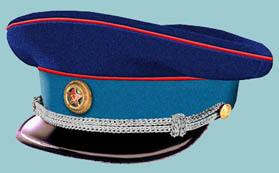
|
The same order announced the statements of the uniform of the police personnel (Appendix 13).
By order of the NKVD of the USSR No. 225 dated March 29, 1943 for the commanding staff of the state traffic inspectorate, it was established that the emblems of the engineering and technical staff - "a key and a hammer", were worn on shoulder straps.
V clarification of the OBSP GUM of the NKVD of the USSR No. 29 / p1672 of June 29, 1943 explanations were given on the imposition of cipher stencils on the shoulder straps of junior command personnel and police officers. The cipher for imposing a stencil on shoulder straps was installed only for privates and junior command personnel of combat units, railway and water departments, and city police departments. On the shoulder straps of the railway police, a cipher was installed - a metal key with a hammer, and for the water police - a white anchor. Ordinary and junior command staff of the district police departments wore shoulder straps without a stencil. Shoulder straps made of silver braid with a special weave with red edging, removable. Asterisks on shoulder straps are of golden color, sewn. The buttonholes on the overcoat are longitudinal, red, edged with silvery embroidery from the gimp, with large brass buttons at the end. On the collar, parallel to the colored piping, there is a silver double piping. On the front end of the collar, a narrow silver laurel branch is sewn. Closed woolen tunic, blue, with two welt chest pockets, with a single-wing flap without a fastener. Jacket clasp with five brass buttons, stand-up collar. Sewn-in sleeve with cuff. There is a red edging on the collar and top of the cuff. Shoulder straps of the established pattern. In summer, it was allowed to wear a white tunic with a cut similar to a blue tunic, but without edging (Table 83). Cap made of blue woolen fabric, band and edging made of red instrument cloth. Black lacquered visor. On the front, above the visor, there is a filigree strap made of silver treadmill. Badge of the established pattern. In summer, the cap was allowed to be worn with a white case.

|

|
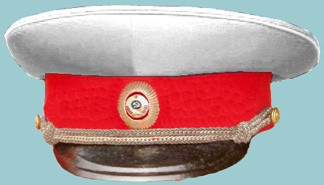
|
For the senior and middle commanding staff of the militia, the following uniform was established:
Overcoat made of blue cloth, double-breasted, clasp for six large brass buttons arranged in two rows with the image of a five-pointed star with a sickle and a hammer in the center. Sewn-in sleeve with cuff. Along the edge of the collar, along the side, cuffs, pocket flaps, posts, tab and slot - edging made of red cloth. (Table 78). On the collar there are red rectangular buttonholes with dark blue edging, with large sewn buttons.

|

|
Oversized trousers and breeches blue, with red piping in the side seams.
Cap made of blue woolen fabric, rim and piping - red. Visor and chin strap - black, lacquered. Badge of the established pattern. Equipment leather brown with a shoulder harness, two-pin brass buckle. In full dress uniform, the shoulder harness was not worn.
In winter, a collar made of natural black tsigeika, edged with red cloth, was fastened to the overcoat of the command personnel. For privates and sergeants of the militia, the following uniform is established:
Overcoat in cut and color it is similar to the overcoat of the senior and middle command personnel. For winter time, a fur collar made of natural black tsigeika fur with red edging was fastened to the overcoat. Buttonholes of the established color and pattern were sewn on the back of the collar. Peaked cap, Kubanka hat and breeches are also similar to the specified items of uniforms for senior and middle command personnel.

|

|

|

|

|
Militiaman |
Senior policeman |
Lance Sergeant
|

|

|
|
Police Sergeant |
Staff Sergeant
|
Police chief |

|

|

|
Police cadet |
Senior cadet |
Junior cadet
|

|

|

|
Cadet sergeant
|
Senior cadet
|
Cadet-sergeant-major
|
V summer time the rank and file were allowed to wear a tunic and a summer officer's jacket. By order of the Ministry of State Security of the USSR No. 0155 dated 30.10.1950 a uniform uniform was announced for the officers and enlisted personnel of the militia of the entire Soviet Union. By order of the Ministry of State Security of the USSR No. 15 of 17.01. 1953 g. The revolving cord from the red garus was removed from the supply for the privates and junior commanding staff of the militia. By order of the Ministry of Internal Affairs of the USSR No. 193 the red edging on the overcoats of the commanders and rank and file of the militia, except for the militia commissars, was canceled.
Order of the Ministry of Internal Affairs of the USSR No. 193 dated 27.03. 1956, In order to improve the supply of police officers, establish uniformity of uniforms, and strengthen the responsibility of employees for a careful and accurate attitude to their uniforms, transport police, traffic control departments, and traffic safety services, a uniform was established that was common to all police. By order of the Ministry of Internal Affairs of the USSR No. 437 of 12.06. 1957 g. for the personnel of the ORUD, the OBD and the transport police, sleeve decals were installed.
The sleeve insignia was a rhombus in size between opposite corners: vertically - 50 mm, horizontally - 90 mm. A metal letter is attached in the center of the rhombus yellow color height 23 mm: for the personnel of the ORUD (traffic control department) and OBD (traffic safety department) - "R", transport police - "T". The rhombus was made of dark blue fabric with red edging.
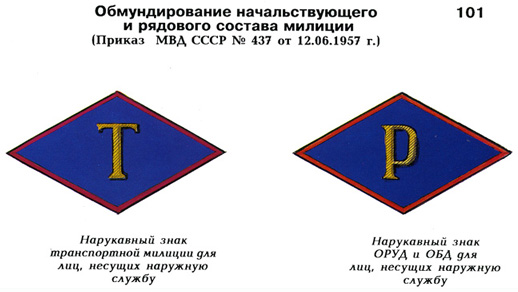
|
- Preobrazhensky - professor from the novel "Heart of a Dog": character quotes, image and characterization of the hero Scientist from the heart of a dog
- Composition on the painting Seeing off the militia of Raksha Yu
- Lindgren "Pippi Longstocking"
- Dragoon "Enchanted letter
- Summary of a literary reading lesson on the topic: J.
- Fairy tale The Princess and the Pea read
- Three "evening tales" of the lion and irina tokmakov
- Daphne - Myths of Ancient Greece Despair of the nymph Cletia
- Three "evening tales" of the lion and irina tokmakovs Story by irina tokmakova who to be read online
- "Apollo and Daphne": a sculpture based on ancient Greek myth
- Mouse and pencil - Suteev V
- Veresaev vikenty vikent'evich
- Vasily Shukshin: Until the third cocks Until the first cocks shukshin
- Svyatogor what he did in the epic
- "Scene with a wounded buffalo"
- VII International Competition "New Fairy Tales" Competition for Writers of Fairy Tales for Adults
- Important organizational points
- Portfolio of the music director of the autonomous preschool institution of the municipality zavodoukovsky urban district "development center
- Awarding of winners and participants of the competition
- D and collect portrait templates









